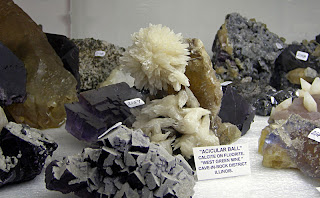This unknown fossil (bone?) was found near the fluorite mines of Marion, Kentucky. My cousin sent me this picture while visiting the Ben E. Clement Mineral Museum last weekend. He told me it is a great museum to visit in an out of the way part of Kentucky. They had a fossil displays as well at the museum including the one of corals and petrified wood in the following picture.
Of course, they have mineral specimens from around the world including this vivianite spray from Bolivia and blue fluorite from Bingham, New Mexico.
The main attraction is the fluorite and the Marion mines produced it! Here are some specimens from around the area.
If you are interested in finding out more, below is information about upcoming mineral digs and their annual show.
Dig Fluorite and related minerals during the day and fluorescent minerals at night.
Scheduled Digs for 2010
- April 17
- May 15
- June 5th & 6th (during museum's annual gem & mineral show)
- July 10
- August 7
- September 11
- October 9
For More Information Contact:
The Ben E. Clement Mineral Museum
PO Box 391 Marion, KY 42064
Phone: (270) 965-4263
E-mail: beclement@kynet.biz
Website: clementmineralmuseum.org
5th Annual Ben E. Clement Gem, Mineral, Fossil, & Jewelry Show
June 5-6, 2010at
Historic Fohs Hall
201 North Walker Street
Marion, KY
(Next door to the museum)
Events & Activities
- Museum Tours Event Speakers
- Vendor Tables Silent Auctions
- Day and Night Digs
- Children’s Activities
- Hourly Door Prizes
Saturday 9 AM-5 PM
Sunday 11 AM - 5 PM





Hi,
ReplyDeletethe unknown fossil in the first picture looks like an internal mould of the bivalve megalodon
^^Yep, I concure. The rocks of Marion Co. are Ordovician.
ReplyDeleteSolius
I should add... I think that Megalodon is a Mesozoic species.
ReplyDeleteThis appears to be a cyrtodontid. I have found some rather large ones, locally.
Solius
Thank you both for the identifications. I sent a message to my cousin about them and he will inform the museum.
ReplyDeleteI received an e-mail with an identification of the mystery fossil:
ReplyDelete" this appears to be the internal cast of of what is commonly called Ox-Heart Cockle (Glossushumanus) although this may be a related extinct species.) I don't recall, off hand what the earliest occurrence of the genus was but I am fairly sure it is Cenozoic--likely this was washed into a sinkhole after the Cretaceous which would account for it being found in much older formations."
Here is a link to see pictures.
Thanks for the comment.
Heidi e-mailed me with a possible identification for this fossil as well: "I came across a very similar fossil as the one you list as “unknown fossil”. As a matter of fact, several were found in North Myrtle Beach, SC. Wanting to know what they were, I searched and first found your posting. I kept searching and finally found out the fossil is called a cucullaea steinkern. Basically, a fossilized clam."
ReplyDeleteThanks for the feedback!
It seems that is internal diecast of bivalvia Cucullaea
ReplyDeleteIt is internal diecast of bivalvia Cucullaea
ReplyDelete